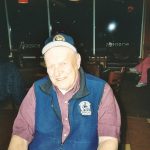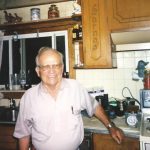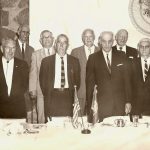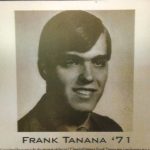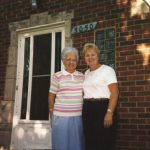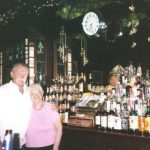West Side Detroit Polish American Historical Society
Transcript of Neighborhood Tour with Edward J. Sarna (“ES”)
Wednesday, August 1, 2007
ES: This is where we had our shower.
INTERVIEWER: Oh, now here we are on the corner of Dennis and Gilbert. And it’s the Open Door Baptist Church. It used to be a hall. It’s where Mr. and Mrs. Sarna had their wedding shower. Right next to 3458, whatever street we’re on.
ES: No, I think this is Cicotte.
INTERVIEWER: Cicotte approaching Otis.
ES: This used to be a hardware store.
INTERVIEWER: And right on the corner, which is 3400 Cicotte, used to be a hardware store. It’s an orange brick building. It appears to be boarded up now, vacant.
ES: 6415 Otis, that’s where I met my wife.
INTERVIEWER: 6415 Otis. Now, is that where she was living?
ES: She was living there, yeah. She was born there.
INTERVIEWER: It’s where Mrs. Sarna was born.
ES: And her grandfather built the house.
INTERVIEWER: Oh, my. Her grandfather built the house. How did they learn how to do that?
ES: This used to be Cozy Cove. This used to be where the pigeon jockeys used to all come.
INTERVIEWER: The pigeon jockeys?
ES: Yeah. They had racing pigeons and everything. And this was the old K of C Hall.
INTERVIEWER: Okay, the Cozy Cove is the white bar on the corner of Gilbert and Otis. And the K of C Hall is across the street from it.
ES: This used to be a K of C.
INTERVIEWER: Used to be the K of C. The red brick building directly across from it, 3401 Otis. 3201 used to be the Cozy Cove. Now did they have dancing and bands and everything in that Cozy Cove?
ES: No.
INTERVIEWER: It was just a drinking bar?
ES: Just drinking, and pigeon jockeys were really there, I mean, they used to be there almost every day. Just vacant field now. This used to be a gas station and repair now.
INTERVIEWER: Vacant field on Otis and Livernois.
ES: This was always a-
INTERVIEWER: It was a gas station. 3401 was a market. Did you know the people who owned it?
ES: No.
INTERVIEWER: Now we’re crossing Livernois.
ES: There used to be another bar here. Like I say, every corner was a bar almost.
INTERVIEWER: Otis and Military. And a white building with brick on the bottom used to be a bar. Address looks like 3401.
ES: And Daily Bakery used to be here.
INTERVIEWER: The vacant field used to be Daily Bakery. Now filled with Queen’s Anne’s lace. We’re approaching Hammond Street.
ES: This used to be a coal yard right down here.
INTERVIEWER: We’re turning onto Hammond off Otis. What direction are we going in now?
ES: We’re going south.
INTERVIEWER: South on Hammond.
ES: See, you used to have railroad tracks here, all the ties.
INTERVIEWER: Was that where the coal yard was, over here?
ES: I think the coal yard was right over here.
INTERVIEWER: On Stark and Hammond is where the coal yard used to be. Now we’re approaching John Kronk. Are you familiar with Military Auto Parts?
ES: No.
INTERVIEWER: My uncle and my cousin owned it.
ES: Where was it at?
INTERVIEWER: It was on Military.
ES: This is Military.
INTERVIEWER: It was right around here. I think it was that way. It was the other side of John Kronk.
ES: How long ago did he sell it?
INTERVIEWER: It was about eight years ago. It was a family business for, you know, seventy some years. It was a coal business before it was auto parts. Oh, that’s a pretty house. Some of the houses in here are really beautiful. But would you say this is a rough neighborhood?
ES: I would say so, yeah.
INTERVIEWER: As pretty as it looks. Looks can be deceiving. Like a photograph. I see graffiti on the fences, on the sides of the garages. Looks like gang graffiti.
ES: These tracks used to go all the way down. There’s the old Kelsey-Hayes.
INTERVIEWER: Oh, yeah, okay.
ES: This was another bar, here.
INTERVIEWER: Now we’re on the corner of Wesson and Otis. Oh, my, this burned out, trashed building, a blue grate stretched over the door and graffiti all over it, used to be a little bar. St. Hedwig and Wesson.
ES: All these corner stores used to be grocery stores.
INTERVIEWER: 3250 Wesson and St. Hedwig used to be a grocery store. It’s now the Midnight Inn, or something like that. By the way, this is Wednesday, August 1, 2007, and Mr. Edward Sarna is taking me on a neighborhood tour of the west side of Detroit. And we’re trying to envision it the way it used to be.
ES: This used to be an ice skating rink there. That used to be the building where you used to rent skates and everything.
INTERVIEWER: Oh, a big green building now covered with graffiti on Wesson and-can’t see the sign.
ES: And the ballpark used to be there.
INTERVIEWER: Used to be a ballpark. There was an ice skating rink, and the big green building is where they used to rent skates. Wesson and Konkel. How sad. You know, the immigrants didn’t have much. They didn’t have much of anything, but they had so much.
ES: They took care of things, too.
INTERVIEWER: They took care of it, right. Now, we looked at that building, right? What was that?
ES: That’s where we came down.
INTERVIEWER: Oh, okay.
ES: That used to be a bar or grocery store. Every corner almost. Like I say, before the supermarkets came, I mean, that’s all we had.
INTERVIEWER: You had to be able to walk to get your groceries.
ES: Now this was St. Hedwig High School. This was all part of it.
INTERVIEWER: St. Hedwig School. Used to be St. Hedwig School. Is this building being used for anything right now?
ES: I don’t know if it is or not. It might be for Spanish or whatever. See, they used to have downstairs and upstairs filled with church people.
INTERVIEWER: Coming up St. Hedwig, going east, hitting Junction now. Coming up onto the front of St. Hedwig Church now. Now that was a funeral home over there, wasn’t it?
ES: Yeah.
INTERVIEWER: Do you remember the name of it?
ES: I forget the name.
INTERVIEWER: Across from St. Hedwig there was a funeral home. And didn’t you say there was a grocery store? Somebody said there was a grocery store across, or a bakery across from St. Hedwig.
ES: I don’t know about a grocery store.
INTERVIEWER: I thought Greg said there was a bakery. This building burned down one night when we had our board meeting, and then another night when we had our other board meeting six months later, the other building across the street burned down.
ES: I think this used to be a barber shop.
INTERVIEWER: 3336 Junction, and 3338 used to be a barber shop.
ES: This used to be Otis Bar here, that’s where I broke my wrist.
INTERVIEWER: Oh! In a fight? [Laughter]
ES: No, listening to Polish music. They chased me down the stairs because I wasn’t old enough to go in the bar. [Laughter]
INTERVIEWER: You’re kidding me.
ES: No.
INTERVIEWER: On the corner of Otis and Junction, vacant lot, used to be, what was it? Otis Bar?
ES: Otis Bar.
INTERVIEWER: Mr. Sarna made history there. Broke his wrist. And what was this?
ES: Used to be an old gas station.
INTERVIEWER: I always wondered about this little castle. [The white building to the south of the Dom Polski]
ES: Yeah. Used to be a gas station, one pump in there, and I used to live right behind it.
INTERVIEWER: Really?
ES: Yeah, it’s all torn down.
INTERVIEWER: What was the purpose of that little castle-looking building?
ES: It was just the style of the gas station before.
INTERVIEWER: One-pump gas station at one time. There’s the Dom Polski with the proud Scottish flag flying above it.
ES: This used to be the lawyer’s office right next door here, that’s where my mother-
INTERVIEWER: Oh, the lawyer’s office used to be right to the north of the Dom Polski.
ES: A bar used to be here. Used to be another bar here.
INTERVIEWER: Another bar was the blue building across the street from the Dom Polski. It’s now Iglesia Pentecostal.
ES: Another gas station there.
INTERVIEWER: Junction and Kopernick was another gas station, that little white building.
ES: This used to be a bar here, where we went to watch movies.
INTERVIEWER: Vacant lot on the northeast corner of Kopernick and Junction was a bar.
INTERVIEWER: Look at that beautiful garden in front of that house with the Virgin Mary. Lockwood and Kopernick.
ES: Yeah.
INTERVIEWER: Beautiful house with a garden and a statue of the Virgin Mary in front of the house. A gardener must live there.
ES: I think this corner here was where they used to have a book-binding company, and I think I worked there for about a week or so.
INTERVIEWER: Michigan and Lockwood, 4835, a book-binding company. Why did you only work there a week, did you get fired? [Laughter]
ES: No, I guess I didn’t care for it.
INTERVIEWER: It wasn’t your thing, huh? Junction Clinic Pharmacy.
ES: Now, all along the other side used to be furniture stores. That’s how I met my wife. She used to work at that furniture store on 30th.
INTERVIEWER: Oh, 30th and Michigan was a furniture store.
ES: I forget the name of it.
INTERVIEWER: And your wife worked there?
ES: Yeah. That’s where we bought all our furniture.
INTERVIEWER: That’s where you bought all your furniture.
ES: I think it was Mars Furniture.
INTERVIEWER: Mars Furniture.
ES: And this used to be a big cleaners. A guy opened it up after he got out of the service.
INTERVIEWER: Goldner and Michigan was a big cleaners on the south side of Michigan. I can just imagine you guys driving around these streets going to your parties and everything. What a life that was. You didn’t even have to worry about crime, did you?
ES: No.
INTERVIEWER: Here’s another beautiful garden, although it’s mostly wildflowers. I guess it’s not so beautiful.
ES: Okay, this used to be Lockwood Bakery.
INTERVIEWER: Lockwood Bakery. Lockwood and Otis, behind the big brown house.
ES: This used to be another bar on the other corner there. Like I say, they had bars on every corner, and everything was busy.
INTERVIEWER: A vacant field on Otis and Lockwood, looks like the southwest corner was another bar. You could see St. Hedwig off in the distance. What a beautiful view from there. From every bar you could see church steeples. [Laughter]
ES: Yeah.
INTERVIEWER: And from every church you could see a bar. There’s that beautiful garden again. Another world.
ES: This used to be the old Cadillac Motor Car Company.
INTERVIEWER: Yeah, here we go. We’re turning south on Clark Street off Michigan. Cadillac Motor Car Company. There’s an era that we’ll never see again. All vacant property, land for sale. How many kids went to college off their parents’ paychecks. Those were good jobs. And you know, it used to be frowned upon. My generation, growing up, we thought factory jobs were not the greatest thing. You know, college was always emphasized. But now, these younger people, and even people of my generation would give anything for a factory job, to be able to go into a place and get a secure factory job and know that you wouldn’t be laid off. What you wouldn’t give for that. Who would have ever thought those days would disappear.
ES: I didn’t realize they tore all this down.
INTERVIEWER: Haven’t been by here in a while, yeah. Oh, you can see St. Hedwig from here. Very clearly.
ES: Yeah, we used to take our sleds in the wintertime and come down this hill, right from the top and then go all the way down and then turn the corner around.
INTERVIEWER: Right onto Michigan?
ES: Well, we weren’t on Michigan, but we’d move on the sidewalks, like, you know. Then we’d have to walk back up there, get a ride back down.
INTERVIEWER: Sled hill on the north side of Clark and Michigan. We’re still going east on Michigan. Can see downtown skyline in the haze ahead. All kinds of graffiti on the sides of these buildings.
ES: Down here, big junkyard.
INTERVIEWER: Junkyard on Vinewood and Michigan on the north side, used to be.
ES: West Grand Boulevard and Michigan used to be a big bowling alley.
INTERVIEWER: On the north side of Michigan and West Grand Boulevard, used to be a bowling alley, northwest corner. Burned down.
ES: Used to be Wayne Bolt & Nut.
INTERVIEWER: Wayne Bolt & Nut, 3655, south side of Michigan near 25th Street. That Hygrade’s has been there for a long time. Is that where your mom worked, over there?
ES: No, Hygrade’s factory. That’s where I was going to take you.
INTERVIEWER: Oh, okay.
ES: It’s right on the expressway.
INTERVIEWER: I always liked this building with the little peaked-
ES: That used to be a sausage place where we used to buy our sausage. Used to be like a wholesale meat market.
INTERVIEWER: You don’t know what this building on Michigan and 23rd was, do you?
ES: No. And all this space right on the overpass here, that used to be Hygrade’s. On the south side of Michigan.
INTERVIEWER: Oh, south side of Michigan.
ES: This was part of 75.
INTERVIEWER: By the 75 overpass. This was all the Hygrade’s factory.
ES: Factory. They used to slaughter them there and everything.
INTERVIEWER: That’s where they slaughtered all the animals. That’s where Mr. Sarna’s mother worked.
ES: I couldn’t imagine how she put up with that smell.
INTERVIEWER: I can’t imagine how the immigrants did what they did to stay alive, but they did it to stay alive.
ES: Yeah.
INTERVIEWER: Put food on the table for their kids.
ES: My mother and my mother-in-law used to work there, plus my uncles, and a lot of Polish immigrants.
INTERVIEWER: And, of course, those were the good jobs for them. They were happy to get those jobs. If you were really lucky, you could get an office job, like at the railroad.
ES: See, it’s all dilapidated now.
INTERVIEWER: I worked in that building, did I ever tell you that?
ES: You did?
INTERVIEWER: Yeah. I worked in there in the late ’70s and early ’80s.
ES: Yeah. My brother-in-law used to work there.
INTERVIEWER: I loved that job. I loved that building. There was something very other-worldly about it. I loved being in there. Even, you know, even then it was dilapidated and beginning to-well, it was more than beginning to crumble. It had seen its glory days. But something about being in there was very nostalgic. Coming up on the old Tiger Stadium. What are they going to do with Tiger Stadium?
ES: They said they’re going to save part of it and tear the rest down.
INTERVIEWER: Wonder why they would save part and not take it all down?
ES: It’s for historical value.
INTERVIEWER: Oh, I see. Were you a big baseball fan back then?
ES: No, when we were young, I used to take my wife there. We used to walk always, from here down to where I live now. I just went in there on Friday. They’re supposed to have karaoke. This is the old Nemo’s Bar.
INTERVIEWER: Yeah, Nemo’s Bar. I remember Nemo’s.
ES: Nemo used to have a picnic, and we were at a picnic when they landed on the moon. Now, see, they used to have a bunch of Checker Cabs, and this was their parking lot.
INTERVIEWER: Behind Nemo’s was the Checker Cab parking lot. Now, was Nemo’s here when you were young, also?
ES: Yeah. But, I mean, Nemo’s bought the place after a while.
INTERVIEWER: Look at this building, Spaulding Electric. It says electric motor repairs.
ES: This is where I used to work for 47 years.
INTERVIEWER: You did? Are we going in?
ES: Yeah.
INTERVIEWER: Cool. We’re inside Spaulding. These are the small motors? What are they from?
ES: These are from air compressors or something.
INTERVIEWER: Air compressor motors. They’re like as big as a refrigerator. These are the smaller motors, he tells me. This is the coolest place. You wouldn’t even know it was here if you didn’t know it was here. This center part was built when?
ES: In 1925.
INTERVIEWER: In 1925.
ES: And the front and the back were from the 1800s.
INTERVIEWER: And the front and the back were built in the 1800s. So they added on, obviously. This is amazing. Now was it named after the man who started the business? Spaulding? There was an actual Spaulding?
ES: Well, it was a furniture store at first. They used to make furniture in the back and front part. And then when Spaulding bought it, they named it Spaulding. Spaulding’s been in here since 1911.
INTERVIEWER: It was a furniture store then. Spaulding bought it in 1911. So, any kind of motor? Anybody needs a motor repaired, you-
ES: Electric motors, yeah.
INTERVIEWER: Electric motor.
ES: But nowadays, you can buy a motor cheaper than you can repair it. I’ll show you how we repair them.
INTERVIEWER: How did you get this job?
ES: How did I? I got it from, I went to electric school, and then after a while, I came here and they were hiring, so I started out as an apprentice more or less and worked my way up, and when I left here I was running the whole place. But this is the elevator.
INTERVIEWER: So who’s the boss now?
ES: The third generation. See, you can buy a new motor cheaper than you can repair that one. But when I first started, I mean, we used to do small motors, too.
INTERVIEWER: Now we’re on the second floor.
ES: We used to have a conveyor belt there. This is the old part, you know, back in the 1800s. See all those wood beams? And down in the basement, they didn’t use nails, they would use wood pegs. This is where I started. I used to have to take these motors. I used to have to clear them out with a torch, and that was hot. That was my first job, getting them ready for the winders.
INTERVIEWER: Now, Spaulding I know isn’t Polish.
ES: No, he’s Irish, I think.
INTERVIEWER: Did he employ many Polish people?
ES: No, I was the only one. But there aren’t any more. They used to work 24 hours a day, almost. Almost everything was repairable before, where now you can buy a new one.
INTERVIEWER: So you repaired-
ES: All electric motors.
INTERVIEWER: Motors for machines for the war effort.
ES: Yeah. All commercial, you know, factories, none of the household things.
INTERVIEWER: [Leaving Spaulding Electric, driving west on Michigan Avenue] You knew the guys who put this brick street in?
ES: No, I didn’t know them, but when I first started there, some of the guys that worked there when I came there knew when they put it in. And there used to be streetcar tracks all the way down the center there.
INTERVIEWER: You can still see some of the streetcar rails. Corner of Michigan and 14th was a bank building. It says CPA Building. Northwest corner. We’re turning north on 29th off Michigan. Now we’re turning west on Magnolia. Right on the corner of 30th and Magnolia, just a vacant lot.
ES: It used to be all homes.
INTERVIEWER: Oh, my gosh. 30th and Magnolia, used to be all houses, now it’s just nothing but garbage. [Where Mr. Sarna used to live]
ES: Yeah, vacant.
INTERVIEWER: Vacant fields and wild brush.
ES: Behind this vacant field, they used to have gas lights in there, that’s how old it was.
INTERVIEWER: The house behind 3808 had gas lights. 3907 is a church. Was that always a church? 3907 30th. And this Jackson Street, there’s a school. Might have been Newberry School. Big red school building. 29th and Magnolia. Was it 100 percent Polish in here?
ES: Yeah. All furniture stores.
INTERVIEWER: 30th and Michigan, this whole area was furniture stores. That’s an interesting building.
ES: I forgot that one corner there. It used to be the Crystal Theater.
INTERVIEWER: The Crystal? That big building there?
ES: No, no. It’s just an empty lot now. Federal Store used to be here.
INTERVIEWER: 33rd and Michigan was Federal’s Department Store.
ES: Right between these two buildings you had a confectionery that served soda pops and everything else. That’s where I first had cherry Coke.
INTERVIEWER: Between 5516 and 5532 there was a confectionery. Mr. Sarna had his first cherry Coke there.
ES: There used to be a bank.
INTERVIEWER: Oh, yeah, the old Boys Club of Detroit. Michigan and 35th.
ES: And the Kramer Theater used to be in that vacant lot over there.
INTERVIEWER: Oh, right across the street from it on the south side of Michigan was the Kramer Theater. It’s now a big lot with a black wrought iron fence. It’s now Social Security.
ES: Down on this corner they used to have a bowling alley. I used to pin set when they didn’t have the automatic pin setters.
INTERVIEWER: Big vacant lot on the north side used to be a bowling alley.
ES: They used to have a lot of bowling alleys, too. This was part of Kelsey-Hayes.
INTERVIEWER: What’s now Olympic Steel on the south side, a big blue structure, used to be a part of Kelsey-Hayes.
ES: This hardware store has been there as long as I remember, so that’s over 50 years.
INTERVIEWER: Bright Hardware on the north side, it’s over 50 years old.
ES: They used to have a big motel here, on the corner where the BP gas station is.
INTERVIEWER: Across from it, southeast corner of Livernois and Michigan, was a big hotel, it’s now a BP gas station. Of course, there’s now the old George’s Coney Island, Michigan and Gilbert. Here’s the Senate Theater. We’re at 6422, next to the Senate Theater. Better Made Potato Chips was here. West of the Senate used to be the Coney Island.
ES: Across the street used to be Harnet’s Bakery.
INTERVIEWER: Directly across used to be Harnet’s Bakery. It took up about a half a block. This is a great big interesting building here. Oh, it’s new. Oh, they’re renovating.
ES: His father used to live on Otis, just around where we used to live, that was Mondry’s Hardware. That’s been there a long time.
INTERVIEWER: Mondry Hardware. Yeah, I remember seeing ads for that.
ES: And this used to be another bowling alley.
INTERVIEWER: Another bowling alley right to the west of Mondry. Tel-Way, that’s been there forever.
ES: CVS wanted to buy them but they wouldn’t sell. This used to be a grocery store, and this used to be a beauty shop.
INTERVIEWER: Oh, yeah, 51st and St. Stephen’s, 4400 was a grocery store, 4401 was a beauty shop.
ES: This is the old Central Creamery.
INTERVIEWER: Central Creamery, St. Stephen’s and Central.
ES: They still have the sign up there. And that was Michno’s Bar.
INTERVIEWER: Oh, yeah. On the northwest corner was Michno’s Bar, which is going to be a beauty parlor.
ES: And Kinsel’s used to be here, and the dime stores. Right on the corner here where Little Caesar’s is used to be another bowling alley, bowling alley and pool hall.
INTERVIEWER: That would be the southeast corner of Michigan and Central, that was a bowling alley.
ES: That used to be Rose Café, and that’s where they had that chair that went back and forth.
INTERVIEWER: Oh, yeah, 7627, right next to what used to be the bowling alley. They had the electronic chair that used to go back and forth behind the bar. And was the purpose of that so that the bartender didn’t have to walk?
ES: Yeah. It was somewhat of a novelty in those days, you know. Like I say, they had about three bars right in this block.
INTERVIEWER: Michigan and 52nd. About three bars right in this block.
ES: We used to have a couple right across the street. There used to be a grocery store right next to Dollar ‘N More. There used to be another bar before 52ndShow Bar. You’ve got that in the movie. That used to be Morey’s clubhouse.
INTERVIEWER: Oh, yeah, Morey’s Cocktail Lounge?
ES: Cocktail Lounge, yeah. So that’s about it.
NOTE: It came to our attention after this interview was transcribed and posted that the interviewer states, “Oh, yeah, 51st and St. Stephen’s, 4400 was a grocery store, 4401 was a beauty shop”. We would like to correct the record. In fact, the grocery store was at 4401 until the late 1940s. It later became a beauty shop. 4400 was never a grocery store.
In addition, the bakery (at 6445) was identified as “Harnet’s Bakery,” which was a typo. It should read “Harnick’s Bakery.”
